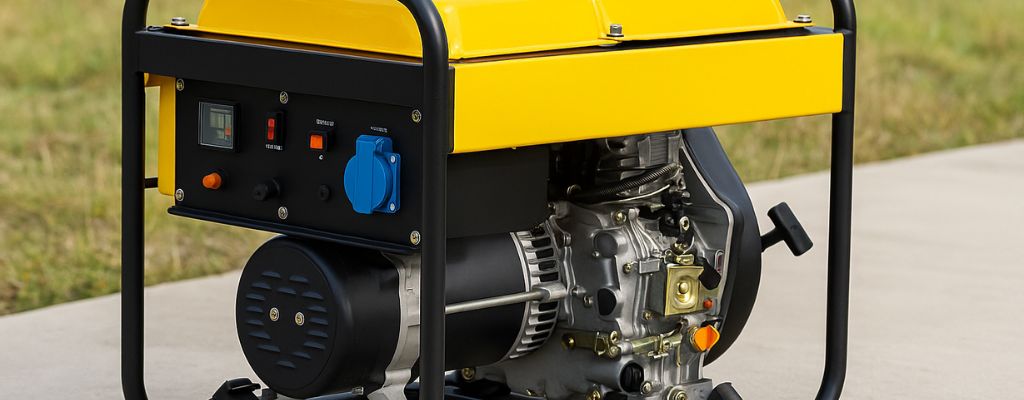
What's a Good Safety Margin for Sizing a Generator?
When sizing a generator, aim for a 10% to 25% safety margin. It’s like packing extra sunscreen for a day at the beach—you're just being smart! Generators need room to handle sudden surges, and this little buffer ensures they run smoothly without overloading. Keep reading to find out why that extra power matters!

Understanding Generator Sizing and the Importance of a Safety Margin
Sizing a generator isn’t just about matching it to your power needs. The safety margin—the gap between the generator’s rated capacity and the load it’ll handle—is crucial. This extra cushion helps ensure that your generator can handle spikes in demand without straining or malfunctioning.
Why a Safety Margin is Crucial for Your Generator's Performance
Preventing Overloading and Premature Wear of Your Generator Components
Without a safety margin, your generator will be running at full capacity all the time. Overloading it regularly leads to quicker wear and tear. Think of it like pushing your car’s engine to the limit. You wouldn’t do that, right? The same goes for your generator. Keeping it within its limits helps it last longer and reduces the need for repairs.
Ensuring Consistent and Stable Power Output from Your Generator
Imagine running a business or keeping your home powered, only for the electricity to drop out every time there’s a sudden surge in demand. With the right safety margin, your generator can handle these surges, ensuring steady and reliable power. This stability is key, whether you're relying on it for daily use or for emergency situations.
What Happens with an Undersized Generator? Risks to Your System
Using a generator that's too small for your needs? It might seem like a quick fix, but it could lead to big problems down the road.
Frequent Tripping and Shutdowns of Your Generator Unit
A generator that’s too small won’t be able to handle the load, causing it to trip or shut down often. It’s like trying to fit a square peg into a round hole—nothing will work as smoothly as it should. These interruptions can be frustrating, especially if you’re relying on the generator for essential power.
Potential Damage to Appliances and Your Generator Itself
An undersized generator may struggle to power your devices properly. Over time, this can damage your appliances and the generator itself. The motor could burn out, and your home’s electrical system might suffer from irregular power flow.
What Happens with an Oversized Generator? Considerations for Efficiency
So, you’re thinking, “Bigger is better, right?” Well, not necessarily. While an oversized generator might sound like a good idea, it can bring along a set of problems.
Increased Upfront Costs and Fuel Inefficiency for Your Generator
Larger generators tend to cost more upfront and may consume more fuel than you actually need. Running a big generator for a small load is like driving a monster truck in a city—it’s powerful, but inefficient. This means higher fuel costs and more money spent than necessary.
"Wet Stacking" and Other Issues from Light Loading Your Diesel Generator
If you’re running a diesel generator with too little load, you could face “wet stacking.” This is when unburned fuel builds up in the engine, leading to inefficiencies and potential damage. It’s a good reason why choosing the right size is essential—not too big, not too small, but just right.

Calculating Your Generator's Power Needs and Utilizing Sizing Resources
Now that you know the importance of a safety margin, let’s look at how to accurately calculate your generator’s power needs for the perfect size.
Generator Sizing Calculator: Leveraging Tools for Accuracy
Online Calculators and Software for Estimating Your Generator's Requirements
There are several tools online that make sizing a generator a breeze. They help you input your power needs and get an accurate estimate of the generator size required. These calculators take the guesswork out of the equation, making it easier to choose the right generator for your situation.
Understanding Inputs for Precise Sizing of Your Generator
When using a generator sizing calculator, it’s important to input the right information. You’ll need to account for both running and starting loads. For example, when starting a motor, it may draw several times more power than when it’s running. Make sure you input those peak values for accuracy.
Generator Capacity in kVA and kW: Understanding Units for Your Generator
You’ll encounter two common units when sizing a generator: kVA (kilovolt-amperes) and kW (kilowatts). Here’s the difference, so you know what you’re working with.
Standard Generator Sizes kVA: Common Capacities Available
Generators are typically rated in kVA, which represents the total power they can supply. Small generators may be rated at 3 kVA, while larger units can exceed 1,000 kVA for industrial use. Understanding these sizes helps you pick the right one for your needs.
Standard Generator Sizes kW: Converting Between kVA and kW for Your Generator
While kVA gives you the total power capacity, kW is the usable power. To convert between the two, you can use the formula: kW = kVA x Power Factor. This is important when you need to figure out exactly how much usable power your generator will provide.
Utilizing Charts and Lists for Your Generator Sizing
Sizing charts and lists are incredibly helpful when deciding what size generator you need.
What Size Generator Do I Need for My House Chart: Practical Guides for Residential Use
If you’re powering a home, size charts are a good place to start. They provide a guide based on your household’s power needs. Typically, residential generators range from 5-10 kW, but larger homes or those with multiple appliances may require more.
Diesel Generator Size Chart: Specific Considerations for Diesel Units
Diesel generators have their own sizing considerations due to their higher efficiency and unique power output. A diesel generator might be ideal for larger power requirements or industrial settings, so check the charts for these specific needs.
Generator Capacity List: A Comprehensive Overview of Available Generator Power
This list helps you compare different generator models based on power output. Whether you need a small, portable generator or something larger for a business, these charts offer a helpful overview.
Accessing Standard Generator Sizes kVA PDF and Other Resources
Manufacturers and industry bodies often provide helpful resources for generator sizing.
Manufacturer Documentation for Detailed Generator Specifications
Most manufacturers offer downloadable PDFs that detail the specifications of their generators, including sizing guidelines, power ratings, and other important information. These resources are key for making an informed decision.
Industry Guides for Best Practices in Generator Sizing
Industry guides can give you insights into the best practices for sizing generators, particularly for specific applications. Whether you’re powering a home, business, or industrial site, these guides offer valuable advice.

Advanced Considerations and Professional Guidance for Your Generator Sizing
Sometimes, there are factors beyond basic calculations that need to be considered. Let’s dive into these advanced considerations.
Types of Loads and Their Impact on Your Generator Sizing
Your generator needs to be sized based on the type of load it will be powering. Some loads require more power than others.
Resistive vs. Reactive Loads and Power Factor for Your Generator
Resistive loads, like heaters and lights, require straightforward power. But reactive loads, such as motors or transformers, need extra power to handle surges. Make sure your generator can accommodate both types for efficient operation.
Handling Motor Starting Surges with Your Generator's Capacity
Motors draw much more power when they start than when they’re running. It’s essential to size your generator to accommodate these surges. Otherwise, your generator might struggle to keep up, causing system failure.
Generator Overload Protection: How Your Generator Safeguards Itself
Most modern generators come equipped with safety features to prevent overloads.
Built-in Circuit Breakers and Automatic Shutdown Features in Your Generator
Circuit breakers and automatic shutdown features protect your generator from damage. If the load exceeds the generator’s capacity, these mechanisms kick in, shutting down the system to prevent any harm.
The Role of These Protections in Preventing Damage from Overloads to Your Generator
These built-in protections are your generator’s safety net. They ensure that even in the event of an overload, your equipment is safe from major damage, and your system can be reset without costly repairs.
When to Consult a Professional for Your Generator Sizing
For more complex installations or larger systems, professional advice may be necessary.
Complex Electrical Systems and Industrial Generator Applications
If you have a complex electrical system or need an industrial-sized generator, it’s best to consult a professional. They can provide the expertise needed to size the generator accurately for optimal performance.
Ensuring Compliance with Electrical Codes for Your Generator Installation
A professional can also ensure that your generator meets local electrical codes and installation standards, ensuring safety and legal compliance.
Conclusion: Investing in the Right-Sized Generator for Long-Term Reliability
Choosing the right-sized generator with an appropriate safety margin is crucial for ensuring reliable power. By carefully calculating your needs, considering advanced factors, and seeking professional help when necessary, you can make sure your generator is ready for any power demands that come its way. A well-sized generator is an investment in long-term reliability and peace of mind.


